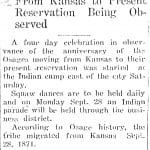Indians Holding 4-Day Celebration
September 27, 1931
The Daily Journal Capital
Microfilm Roll: MN00285
On this day in Osage country, an article published in
The Daily Journal-Capital announced an upcoming celebration held by the Osage tribe in honor of the anniversary of their last migration.
According to the article, the Osages were hosting a celebration to commemorate their last migration from Kansas to the Oklahoma reservation which took place on September 28, 1871. Paul Red Eagle sponsored the event which held daily “squaw dances,” feasts, and an “Indian parade.”
Osage Indians were forced to relocate several times throughout the tribe’s history. In 1808, the Osages were pushed to sign their first treaty with the United States government agreeing to “abandon their lands in Missouri and Arkansas in exchange for minimal compensation and a smaller land base,” (Native History). It has been stated that the United States coerced the relocation by claiming that it was to promote peace between conflicting tribes–tensions that were caused by the government in the first place. The treaty of 1808 ultimately “forced the Osage Nation to cede 52.5 million acres of land in Arkansas and Missouri. In exchange, the Osage received $1,200 in cash and $1,500 in merchandise. Ten years later…the tribe [was] forced to cede its remaining 1.8 million acres in Arkansas and Oklahoma, with no compensation,” (Native History). In 1825, the Osages were forced to sign yet another treaty forcing the tribe to relinquish the rest of their land and to settle within the Kansas border.
In 1868, came the proposal of the Drum Creek Treaty. After much debate and opposition from both sides the Drum Creek Treaty provided the Osages with enough money to purchase land from the Cherokees in Oklahoma, the site of their future reservation. The Removal Act of 1870 was later approved officially relocating the Osage tribe to their new home.
Removal proved to be a long and difficult process for the Osages. In the midst of the government negotiations and forced migrations, the Osage population drastically declined. Their food became scarce; disease spread; and the Osages frequently had to protect themselves from settlers who often intruded onto their lands.
Morgan M. Guzman
“Indians Holding 4-Day Celebration.”
The Daily Journal-Capital. September 27, 1931, p. 1. Microfilm roll number MN00285. Sequoyah National Research Center, Little Rock, Arkansas.
Further Reading
Burns, Louis F.
A History of the Osage People. Tuscaloosa: The University of Alabama Press, 2004.Fitz,
Patrick.
Treaties and Laws of the Osage Nation. Cedar Vale: Press of the Cedar Vale Commercial, 1890.
https://www.loc.gov/law/help/american-indian-consts/PDF/02016475.pdf
Landry, Alyssa. “Native History: Osage Forced to Abandon Lands in Missouri and Arkansas.” Indian Country Today.
https://indiancountrymedianetwork.com/history/events/native-history-osage-forced-to-abandon-lands-in-missouri-and-arkansas/ Date accessed April 23, 2018.
Source File(s)
Related Stories
Related Topics
View more stories in
Tags:

